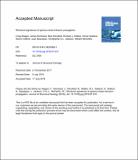Structural signatures of igneous sheet intrusion propagation
Abstract
The geometry and distribution of planar igneous bodies (i.e. sheet intrusions), such as dykes, sills, and inclined sheets, has long been used to determine emplacement mechanics, define melt source locations, and reconstruct palaeostress conditions to shed light on various tectonic and magmatic processes. Since the 1970's we have recognised that sheet intrusions do not necessarily display a continuous, planar geometry, but commonly consist of segments. The morphology of these segments and their connectors is controlled by, and provide insights into, the behaviour of the host rock during emplacement. For example, tensile brittle fracturing leads to the formation of intrusive steps or bridge structures between adjacent segments. In contrast, brittle shear faulting, cataclastic and ductile flow processes, as well as heat-induced viscous flow or fluidization, promotes magma finger development. Textural indicators of magma flow (e.g., rock fabrics) reveal that segments are aligned parallel to the initial sheet propagation direction. Recognising and mapping segment long axes thus allows melt source location hypotheses, derived from sheet distribution and orientation, to be robustly tested. Despite the information that can be obtained from these structural signatures of sheet intrusion propagation, they are largely overlooked by the structural and volcanological communities. To highlight their utility, we briefly review the formation of sheet intrusion segments, discuss how they inform interpretations of magma emplacement, and outline future research directions.
Citation
Magee , C , Muirhead , J , Schofield , N , Walker , R J , Galland , O , Holford , S , Spacapan , J , Jackson , C A-L & McCarthy , W 2019 , ' Structural signatures of igneous sheet intrusion propagation ' , Journal of Structural Geology , vol. 125 , pp. 148-154 . https://doi.org/10.1016/j.jsg.2018.07.010
Publication
Journal of Structural Geology
Status
Peer reviewed
ISSN
0191-8141Type
Journal article
Description
CM acknowledges a Junior Research Fellowship funded by Imperial College London. JDM acknowledges National Science Foundation grant EAR-1654518.Collections
Items in the St Andrews Research Repository are protected by copyright, with all rights reserved, unless otherwise indicated.

